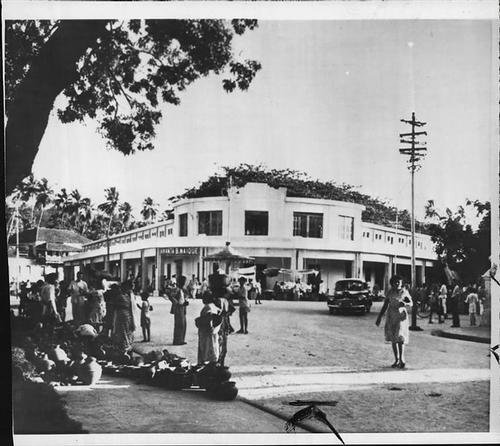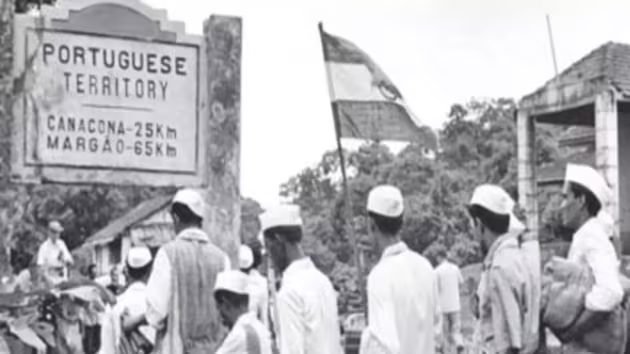Goa, in the Hindu Scriptures, has been named as Gomanta which means the region of cows. It is believed that Parashurama, the sixth reincarnation of Lord Vishnu was the creator of the Goan region. A legend says that he along with ten sages had performed fire sacrifices in the lands of Goa. The gist of Sanskritisation in Goa’s culture is said to be originated with the settlement of Parashurama and the sages from North following whom the people of Goa carry Brahminical hegemony. Walking down the lane of its History we come across another legend according to whom Goa is considered sacred for its spiritually cleansing touch.
This small state on the western coast of India got its name from the Hindu epic “Mahabharata“. It used to be referred to as “Gomantak” signifying fertile land. However, the name Goa was given by Portuguese. Before they arrived in the scenario, Goa, or Gove or Gowapura, was the name only of the port town near the mouth of the Mandovi River. This was also the same site on which the Portuguese later built their capital, which is today’s Old Goa. Let’s take you through a summary of the History Of Goa.

DIFFERENT ERA AND STORIES
1. Myths And Stories From Mahabharata
The history of Goa or Gomantak has been woven into seamless strings of various myths and stories that take us back into the time of Mahabharata. For some, the origin of Goa lies when Parshurama; the sixth incarnation of Vishnu ordered the sea god Varuna to recede the sea to the point his axe struck after he flung it. Lord Varuna then gave up this piece of land till the banks of River Mandovi and River Zuari to Parshurama and Aryan clan accompanying him. This piece of land came to be known as Konkan of which Goa is the southernmost part.
2. The Bronze & Iron Age – Age Of Village God & Goddesses
In 2200 B.C., the first written reference to Goa appears to have been in Cuneiform, in Sumerian times when the King Judea of Lagash called it Gubio. Sumerians had established trade contacts with Goa and many Sumerians settled in Goa and along the Konkan coast. Sumerians are believed to have modified many local customs and introduce their own systems. Few examples of such systems are their style of temple architecture, the Devadasi system, etc. The Sumerians also influenced the language, caste system, and the kinship practices to some extent. Sumerian influence in Goa can also be seen in the entertainment and games of the region.
Even before any king ruled the territory, oligarchic democracy in the form of Gavkari existed in Goa. Gavkari System’s main idea was that village land must belong to the village god or goddess. It consisted of definite boundaries of land from village to village with its topographic detail, its management and social, religious and cultural interaction.
3. Era Of The Great Emperor Ashoka
Goa was a part of the Mauryan empire of Emperor Ashoka. It has been known to other cultures by different names. Two hundred years before Christ, Goa became the southern fringe of the empire of Ashoka. The Aryans had pushed the Dravidian kingdoms to the southern tip of India, such as the Cholas, Pandyas, Tamil Mad, Satyaputras, and Keralaputras. Having an edge over the past helps us understand the history of Goa better.
4. The Era Of Consecutive Hindu Dynasties
Goa was ruled by several dynasties of various origins from the 1st century BC to 1500 AD. For 700 years, a lot of Hindu dynasties ruled Goa. History of Goa is a timeline rule by several dynasties from origins with a different traditional and cultural background.
TIMELINE
One has to know the timeline to figure out the real history of Goa. The various dynasties that controlled Goa during this period are:
1. Scytho-Parthians (2nd -4th century AD)
2. Abhiras, Batpura, and the Bhojas ( 4th – 6th century AD)
Bhojas of Goa are a dynasty that ruled Goa, parts of Konkan, and some parts of Karnataka from at least the 3rd century AD to the 6th century. Goa came under the political sway of the Bhojas who ruled this territory in feudal allegiance to the Mauryan emperor of Pataliputra or perhaps under Shatavahanas. The Bhoja seat of power was located at Chandrapura or Chandraura (Modern Chandor) in Goa
3. Chalukyas ( from 6th – 8th century AD)
4. Rashtrakutas of Malkhed (8th to 10th Century AD)
The Shilaharas of South Konkan ruled Goa from 755 till 1000 AD. Sannaphulla, the founder of the dynasty, was a vassal of the Rashtrakutas. This was a tumultuous period in Goan history. As the Goa Shilahara power waned during the 11th century, the Arab traders gained increasing control of the overseas trade. They enjoyed autonomy from the Shilaharas. In order to control this decline, Kadamba King Guhalladeva I, ruling from Chandor, established secular, political, and economic partnerships with these Arab states. After the Chalukyas defeated the Rashtrakutas, exploiting this situation to their advantage, the Kadamba King, Shashthadeva II, firmly established his rule in Goa. You’ll come across several wars and defeats to realize the real history of Goa.
5. Kadambas (10th to 14th Century AD)
Kadambas ruled from Chandor, over a large part of Goa, but the port of Gopakapattana was not included in the early years. Later King Shashthadeva conquered the island of Goa, including the ports of Gopakpattana and Kapardikadvipa, and annexed a large part of South Konkan to his kingdom. He made Gopakpattana as his secondary capital. His successor, King Jayakeshi I, expanded the Goan kingdom. Guhalladeva III, Jayakeshi II, Shivachitta Paramadideva, Vinshuchitta II and Jayakeshi III dominated Goa’s political scene in the 12th century. During the rule of Kadambas, the name and fame of Goapuri had reached its zenith. Goa’s religion, culture, trade, and arts flourished under the rule of these kings.
6. Bahmani Sultanate ( 1350 AD to 1497 AD )
The rule of Goa switched from Bahmani Sultanate to Vijaynagar rulers and back to Bahmani Sultanate of Gulbarga. When this Sultanate broke up in 1492, Goa became a part of Adil Shah’s Bijapur Sultanate, which established Goa Velha as its second capital. The former Secretariat building in Panaji is a former Adil Shahi palace, later taken over by the Portuguese Viceroys as their official residence. Interesting right? History of Goa has definitely got us intrigued with such details about the past.
Colonialism By The Portuguese Empire
1. CONQUERING
The Portuguese rule in Goa lasted for as long as 450 years. The history of the Portuguese in Goa was similar to the British in India. It is interesting to know that while the Portuguese ruled Goa, their country itself was ruled by Spain from the late 16th century for a period of 60 years. The Portuguese rule in Goa began in 1498. The Portuguese explorer Vasco da Gama landed in Calicut after setting off from Lisbon, in present-day Kerala in 1498. This discovery and the establishment of a new sea route to India around the Cape of Good Hope gave an impetus to the Portuguese who wanted very much to exploit it to their advantage and profit from it. In 1510, when Goa was under Sultan Adil Shah of Bijapur, Portuguese attacked Goa under the command of Alfonso de Albuquerque.
On February 17th he entered the city of Goa for the first time and met little resistance as the Sultan was engaged with his forces elsewhere. Soon after, Sultan came after Alfonso and that led to Alfonso fleeing the city of Goa. Alfonso de Albuquerque made another attempt a few months later. This was a good time Sultan Adil Shah had just died and the heir to the throne was the infant, Ismail Adil Shah. Ela or the city of Goa was under Rasul Khan, one of his generals. After an initial attack on the Arsenal and a quick and bloody battle, Alfonso de Albuquerque victoriously entered the city of Ela, Goa on St. Catherine’s Day, November 25th, 1510.
Who were the first European colonizers in Goa?
Consequently, the Portuguese became the first Europeans to establish their colonies on the Indian sub-continent. Albuquerque did not interfere in Hindu rituals or customs but abolished those which were humanly cruel, such as ‘Sati’. But he massacred all the Muslims in the city as revenge against Adil Shah but left alone the Hindus. By 1543, the Portuguese were able to extend their control over Salcette, Mormugao, and Bardez, thus ending their first phase of expansion into Goa. By this time, Goa became the jewel of Portugal’s eastern empire. The history of Goa remains as mysterious and rich in events as we keep on exploring.
2. SETTLEMENT
Once established in Ela, the Portuguese began a religious conquest, aiming to convert Hindus that had remained in the city. Persuasion rather than force were used to convert at first, and soldiers were encouraged to marry local women thus ensuring Christian children. In 1532, however, the tactics became more forceful. Shrines across the territory were plundered, temples were closed and Hindus were even tortured and killed for failure to convert. Despite these measures, secret temples were still used throughout the crusades.
3. DECLINE
Several factors contributed to Goa’s decline as a Portuguese territory throughout the 17th Century. A recession in Portugal, the spread of diseases such as malaria and typhoid in the colony and the poor position of Old Goa on a river that was beginning to fill with silt all led to the decay and decline of this once rich and prosperous city.
Muslim attacks weakened the Portuguese’s resistance. The Maratha Wars of 1664 to 1739 further destabilized the Portuguese stronghold in India. The Maratha Wars of 1664 to 1739 further destabilized the Portuguese stronghold in India. During this period, the Portuguese slowly expanded their territories which enabled them to extend their control over Bicholim and Safari Pernem, Ponda, Sanguem, Quepem and Canacona in 1791. These acquisitions are known as the” Novas Conquestas. By 1835, all religious orders were banned, and the Hindu majority were granted the freedom to practice their religion. As a result, the “New Conquests” retained their Hindu identity, a characteristic feature is visible even today, and this is also why there is a religious/cultural/language or dialect difference existing in Goa. We’ve got to say every history is written in Blood so is the history of Goa.
Operation Vijay To Liberate Goa From the Portuguese Empire
The Portuguese influence on nearly 500 years of Goan history came to an end on December 17th, 1961 when Indian forces entered Goa, responding to an attack on Indian fishermen by the Portuguese a month earlier. The liberation of Goa, known as Operation Vijay took place with barely a shot fired on either side. Within three days, without much resistance from the small Portuguese force, India liberated Goa. On December 19, 1961, Goa officially became part of India and two years later, held its first general election. It’s important to know every detail to get into the depth of the evolution of goa and nothing can help us know this better other than the history of Goa.

The Indian government declared Goa as a Union Territory. The public voted to decide that Goa would not merge with Maharashtra but remain a Union Territory. Public pressure in the second half of the 1980s led to the recognition of Konkani as an official language in India. Most Goans spoke the Konkani language.
After India’s takeover in 1961, the Hindus that spoke Marathi came to power in Goa’s first democratic elections through MGP. The Maharashtrawadi Gomantak Party (MGP) headed by Dayanand Bandodkar. The history of Goa ends here but with a new beginning – a stronger beginning with a recognition established for good.
On May 31st, 1987 Goa has declared the 25th state of India.
Also read about the Tribal Life of Goa.
Follow us on Instagram to watch few amazing videos of unseen Goan beauty.





